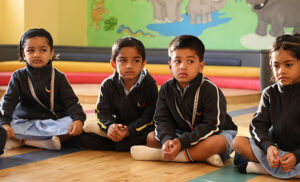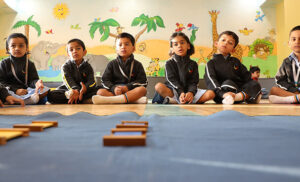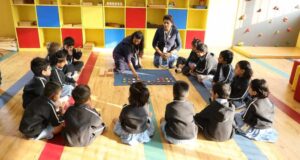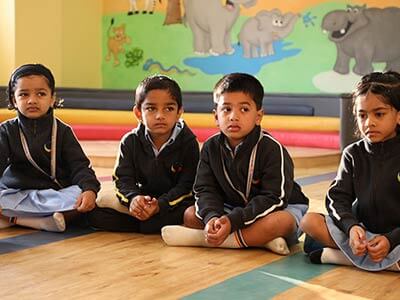Introduction
Rhyming words are an exciting at the same time important part of language learning that helps children develop strong verbal skills. In our daily lives, we hear many words like “bat” and “mat,” but they are not just about sounds, it’s about the rhythm that comes with them. Rhyming is a process that helps children understand language better. Knowing the connection between words is essential for reading and writing. As kids engage with rhymes, they start recognising patterns and sounds too. This makes it easier for them to learn new vocabulary and improve their pronunciation. Rhyming adds a playful element to the entire learning process, making it enjoyable and engaging. Here is a guide to the wonderful rhyming words in english which can boost a child’s love for language.
What is Word Rhyming?
Word rhyming occurs when two or more words sound the same, especially at the end. Example words like “rat” and “hat”, both end with the same sounds, right? Rhyming is more than just a fun game with words, it plays a key role in how children learn to read. Understanding rhymes helps kids hear and work with the sounds in words, which is called phonemic awareness.
When children listen and play with rhymes, they begin to notice patterns in language. And this makes it easier for them to pick up new words and pronounce them correctly. Additionally, a rhyming word adds a playful touch to learning, making it fun and joyful. Also, some research shows that kids who engage in rhyming activities have stronger reading skills and better awareness of sounds in language.
Examples of Rhyming Words
Here are some examples of rhyming words:
Animal Rhymes:
Cat: hat, bat, mat, sat, pat
Dog: log, frog, jog, hog, fog
Nature Rhymes:
Tree: bee, sea, spree, key, flea
Sky: fly, high, my, shy, pie
Action Rhymes:
Run: fun, sun, done, bun, gun
Jump: bump, thump, stump, clump, plump
By including these examples, teachers and parents can create playful songs and poems that engage children while promoting language skills.
Three Stages of Rhyme Learning
The process of learning to rhyme has three exciting stages, each of which is crucial for a child’s verbal skills.
Hearing Rhymes
The first stage is all about hearing rhymes. At this stage, children are made to listen to songs, stories, and nursery rhymes that repeat similar sounds, like “twinkle, twinkle, little star” or “Humpty Dumpty sat on a wall.” By listening to these, they begin to notice the rhythm and patterns in words. According to research children who hear rhymes early on are 40% more likely to have strong reading skills by age five. Imagine how just hearing rhyming words, like in a song, can help set the foundation for reading and language learning in children.
Recognising Rhymes
Once children become familiar with rhyming sounds, they start recognising rhymes themselves. In this stage, they can pick out which words rhyme with what words, when asked to rhyme with “rat” children might say “hat” “bat or “sat” This skill of identifying a rhyming word is a big win because it shows they’re learning to break down words into sounds. Also, fun games like matching rhyming cards can help children playfully connect similar-sounding words.
Producing Rhymes
In the last stage, children start creating their own rhyming words in english, and above all, they start understanding rhyming words meaning. This is when they become creative and start making up rhymes about things they see around them, like “I see a bug on the rug” or “The sun is fun.” By inventing rhymes, they learn to play with words and sounds, which boosts their confidence in speaking and language skills. Hence, encouraging kids to rhyme about their daily activities, like their pets or their toys, makes language learning fun and personal to them.
Benefits of Learning Rhyming Words for Kids
Learning rhyming words offers numerous benefits. Here are some advantages:
- Enhances Vocabulary: Children by nature are very quick in learning, especially at an early age. Hence when introducing rhymes to children like new words and phrases, can help in expanding their vocabulary in a fun and memorable way.
- Improves Phonemic Awareness: Recognising and producing rhyming words in english can promote an understanding of sound structures in language, which is essential for reading proficiency.
- Boosts Memory: Rhymes are catchy and easier to remember, helping in memory retention for young learners. This also makes it simpler for children to recall words and phrases when needed.
- Promotes Creativity: Creating rhymes encourages children to think creatively, enabling them to express themselves through language and develop storytelling skills.
- Strengthens Listening Skills: Listening to rhymes develops auditory discrimination, helping children differentiate between sounds, and also understand rhyming words meaning which is crucial for effective communication.
List of Rhyming Words for Children
Here is a table of the wonderful world of rhymes:
| Words | Rhyming Words |
|---|---|
| Cat | hat, bat, mat, fat, rat |
| Dog | hog, log, hog, jog, frog |
| Sun | run, fun, gun, bun, done |
| Tree | sea, bee, key, flea, spree |
| Ball | tall, wall, mall, fall, call |
| Fish | wish, kiss, dish, swish, squish |
| Light | kite, bite, fight, sight, flight |
| Play | day, say, way, stay, sway |
| Car | jar, far, bar, tar, star |
| Hat | pat, mat, rat, sat, flat |
| Hand | sand, band, land, stand, brand |
| School | pool, fool, tool, cool, rule |
| Book | cook, look, hook, nook, rook |
| Round | sound, found, hound, bound, ground |
| Cold | old, bold, gold, sold, fold |
| King | ring, sing, thing, fling, bring |
| Home | comb, dome, foam, roam, chrome |
| Note | coat, boat, goat, float, quote |
| Tree | bee, key, free, glee, spree |
| Foot | root, loot, boot, toot, suit |
| Wall | call, tall, mall, hall, fall |
| Fire | liar, tire, sire, choir, prior |
| Night | fight, light, sight, bite |
| Star | car, jar, far, bar, tar |
| Rain | gain, pain, train, plain, grain |
| Hand | sand, band, land, stand, strand |
| Hill | will, fill, pill, chill, thrill |
| Bike | hike, mike, like, spike, strike |
| Time | crime, prime, mime, climb, rhyme |
| Sound | round, found, bound, pound, wound |
Tips to Improve Rhyming Skills in Children
- Read Aloud Regularly: Engage with rhyming books daily. Reading aloud and repeating with children is a great idea for better phonemic awareness.
- Sing and Rhyme Together: Use nursery rhymes or create songs to make learning fun and memorable through melody.
- Encourage Creative Writing: Prompt children to write their own rhymes or poems about favourite topics. This playful task will definitely boost their creativity and language exploration.
- Celebrate Their Efforts: Recognise and celebrate every small attempt at rhyming to boost confidence and motivate further to explore language.
Conclusion
Rhyming words are not just fun they’re super helpful in building strong language skills in young children. When children are at the stage where they learn to hear, recognise, and make their own rhymes, they’re practising sounds that make reading and writing easier. Rhymes make learning enjoyable and boost confidence in language, setting a solid foundation for all kinds of learning.
If you’re exploring schools in Pune India, or searching options for CBSE schools in Pune, consider Global Indian International School (GIIS Pune). We offer a supportive space where learning is exciting. We know how important these early skills are. Our approach makes language come alive with creative and fun activities. Rhyming is just one way we help students love words and build strong communication skills for the future!






























